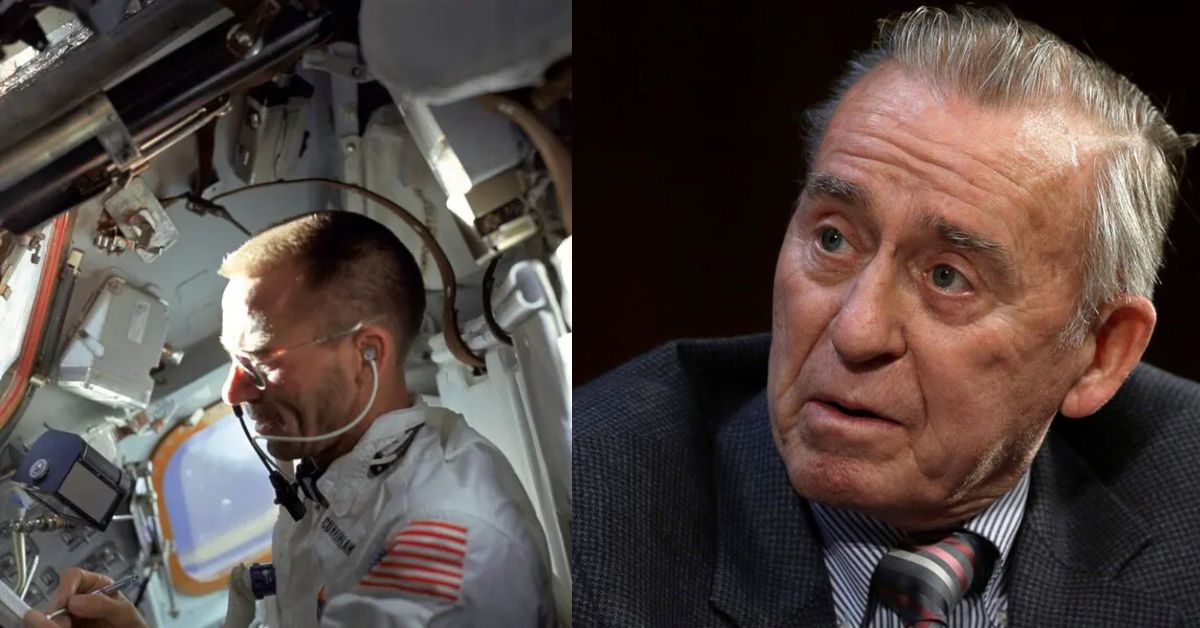Here we are talking about Walter Cunningham Cause of Death. He took part in the first manned Apollo mission in 1968, which helped a nation still reeling from a tragic capsule fire the year before. In the wake of a launch pad disaster that claimed the lives of three astronauts, NASA’s effort to land men on the moon was reinvigorated by Walter Cunningham’s only flight in space on Apollo 7. Walter Cunningham passed away on Tuesday in Houston. He was 90.
His passing was reported by NASA. In October 1968, Maj. Donn F. Eisele of the Air Force, Capt. Walter M. Schirra Jr. of the Navy, and Mr. Cunningham, a physicist and former Marine pilot, embarked on an almost faultless 11-day mission. They became the first NASA astronauts to appear on television from space after completing 163 orbits of the Earth (a distance of four and a half million miles) in a spacecraft that had been extensively modified for safety.
The journey, the first manned Apollo mission, lifted an America reeling from the capsule fire that claimed the lives of Virgil I. Grissom, Roger B. Chaffee, and Edward H. White II at Cape Kennedy, Florida, in January 1967 as they were practicing for an upcoming Apollo 1 mission. In his autobiography, “The All-American Boys,” Mr. Cunningham stated, “We took the nation’s hope with us” (1977).
“Thirty-one months before, a fire on the identical launch pad that we used to launch had claimed the lives of three of our teammates. The chances of sending a man to the moon before 1970 would be permanently lost with only one more setback at this point. He continued, “The mission wasn’t just technical. “We also had to deal with any psychological obstacles that were still there.” Mr. Cunningham, who had a brush cut and was a slim man, appeared to match the astronaut stereotype.
You can also like:
- Lil Keed Cause of Death: You Not Gonna Die at 24 From “natural” Causes!
- Chris Ledesma Cause of Death: What Exactly Happened To Him?
But he had never been a test pilot, unlike many of the other early astronauts. His nomination by NASA was a sign of the organization’s growing enthusiasm for hiring astronauts with scientific backgrounds. After Neil Armstrong, who had flown in the Gemini program and eventually became the first man to set foot on the moon, he was the second civilian to travel into space. Along with the navigator Major Eisele and command pilot Captain Schirra, Mr. Cunningham kept an eye on the systems for the Apollo 7 flight.
Apollo 7 completed its maneuverability and reliability tests before taking them out on October 11, 1968, following unmanned Apollo flights in the wake of the tragic fire. It was clear from the capsule’s rendezvous with an orbiting Saturn 1-B rocket stage that it would easily dock with a lunar module, which would transport two humans from the capsule to the moon and back. The Apollo 7 astronauts, who made up NASA’s first three-person crew, also tested an engine for a future mission that would propel the spacecraft into and out of lunar orbit.
Additionally, astronauts carried a camera that produced TV visuals for the first time. In what became known as “The Wally, Walt, and Donn Show,” they displayed how they could float in their weightless environment and created a hand-lettered sign that read, “Hello From the Lovely Apollo Room, High Atop Everything.” But there was a problem: Major Eisele and Captain Schirra both had colds, and Mr. Cunningham, as he would later recall, felt “a little blah.”
As the astronauts returned to Earth, NASA worried that the cold would cause the astronauts’ eardrums to burst. When they splashed down less than a mile off target, 325 miles south of Bermuda, they were actually in perfect condition. Apollo 8 orbited the moon as a result of their mission’s success, which served as another significant precursor to the moon landing in July 1969. However, Apollo 7 has some flaws. Captain Schirra’s disagreements with Houston-based NASA controllers would go down in history.
He objected to the agency’s ambitious TV transmission schedule, which he felt stole crucial time away from the astronauts’ jobs while speaking into an open microphone that the press was seeing. In addition, he requested that the astronauts not wear pressurized helmets during re-entry, out of concern that this could harm their eardrums given their colds. He was successful in getting what he wanted.
After Apollo 7, Captain Schirra, who participated in the Mercury and Gemini programs, informed NASA that he intended to retire. For both Mr. Cunningham and Major Eisele, that mission turned out to be not just their first but also their final. In his autobiography, “Failure Is Not an Option,” Gene Kranz, one of the flight directors for Apollo 7, said, “I never figured out why Schirra had such a burr under his saddle” (2000).
“Perhaps he was simply unable to handle the annoyance of having something as little as a cold interfere with the vacation of a lifetime. In any case, the two younger astronauts’ careers took a hit. Cunningham and Eisele didn’t make another space flight. In his autobiography “Flight: My Life in Mission Control” (2001), Chris Kraft, the director of flight operations for the Apollo program, claimed that Mr. Cunningham and Major Eisele had backed Captain Schirra on the helmet matter.
When choosing the crews for the Apollo flights, Donald Slayton, Mr. Kraft stated he thought their collective stance was “insubordinate” and he recalled telling him that “this crew shouldn’t fly again.” The chance of Mr. Cunningham flying again was held up by Mr. Kraft in his account of Mr. Cunningham’s later admission to him that “he was in a tight position up there with a headstrong and irate captain.” He never did, though.
Major Eisele’s last opportunity to return to space was as a member of the backup crew for Apollo 10, which orbited the moon and rendezvoused with the lunar module. Captain Schirra saw every interaction with the ground controllers as “a challenge to his authority and judgment as captain of the ship,” according to Mr. Cunningham, who also stated that “I did not feel justified in the behavior and abuse that was being heaped on the ground.”
Although “we were collectively never hauled on the carpet,” he claimed that Captain Schirra’s actions “tarred and feathered” the entire crew. The astronauts on Apollo 7 were forced to accept NASA’s second-highest honor, the Exceptional Service Medal, while crews on later Apollo missions and the Skylab program received the highest honor, the Distinguished Service Medal. At a ceremony in October 2008, NASA upgraded the Apollo 7 astronauts’ medals to the Distinguished Service citation, citing the mission’s success despite their disagreements with the flight controllers.
But at that point, just Mr. Cunningham’s staff was still alive. Captain Schirra, who passed away in 2007, was represented by astronaut Bill Anders, while Major Eisele, who passed away in 1987, was represented by his widow Susan Eisele-Black. Mr. Kraft adopted a tolerant attitude. He said in a recorded message to Mr. Cunningham, “We gave you a hard time once, but you surely survived that and have done quite well since.” You’ve done great for NASA and yourself, and I’m honestly extremely happy to call you a friend.
The oldest of five children, Ronnie Walter Cunningham was born on March 16, 1932, in Creston, Iowa. Walter, his father, had a little construction company. His family relocated to Venice, California when he was a little child. In 1951, he joined the Navy, and during the Korean War, he piloted Marine fighters. He graduated from the University of California, Los Angeles with a bachelor’s and a master’s in physics after quitting the military in 1956.
He was chosen for NASA’s third batch of astronauts in October 1963 while working for the RAND Corporation and pursuing doctoral studies. Mr. Cunningham was appointed director of the program that became known as Skylab, which created America’s first space station, not long after Apollo 7 was launched. In 1970, Pete Conrad, an astronaut, took his place. The following year, Mr. Cunningham left NASA after being turned down for a flight assignment for upcoming missions of Skylab.
Later, Mr. Cunningham rose to the position of a senior executive at several financial and real estate firms. He collaborated with several retired astronauts and NASA personnel in 2012 to write a letter to the organization condemning what they considered was its unsupported claims that carbon dioxide from human activity was a significant contributor to global warming. According to militarytimes.com, Mr. Cunningham is survived by his wife Dorothy; their children Brian and Kimberly; and a sister named Cathy Cunningham.
Mr. Cunningham stated, in reflecting on his time at NASA, that it had given him the confidence to meet any challenges that lay ahead. When he was in charge of a $1 billion Houston real estate development in 1972, he told The Times, “I consider it a spectacle I took part in.” I left with the impression that there was nothing I couldn’t handle. When asked if there was anything he observed in space that had changed him, he replied, “I am a physicist, and everything I encountered on the voyage can be explained.” It did not alter my perspective on religion, life, or the world. It didn’t reveal anything.
Walter Cunningham Cause of Death?
The only surviving member of the first NASA mission to ever broadcast live TV from orbit, US astronaut Walter Cunningham, passed away on January 3, 2023, at the age of 90. Cunningham’s passing was confirmed by Nasa, which noted that he “was vital to the success of our Moon landing program.” He passed away on Tuesday, January 3, 2023, at a hospital in Houston from natural causes “after a full and complete life,” according to a family representative.
In a statement released by Nasa, the US space agency, the Cunningham family stated, “We would want to convey our tremendous pleasure in the life that he lived, and our heartfelt gratitude for the man that he was – a patriot, an explorer, pilot, astronaut, husband, brother, and father.” Another great hero has left the earth, and we shall miss him terribly. Apollo 7 was an 11-day manned mission that took place in 1968 to test the feasibility of space docking and rendezvous. However, the crew’s broadcast was also honored with an Emmy. It opened the door for Apollo 11’s moon landing less than a year later.
Must Check:
- Alan Rankine Cause of Death: How Did He Die at the Age of 64?
- What is The Uche Nwaneri Cause of Death? How Did He Passed Away?
If you find the information presented here fascinating and want to find out more, please return to this website regularly to check for changes. Please visit lakecountyfloridanews.com if you are interested in obtaining background information or answers to any questions you have posed about this topic.





